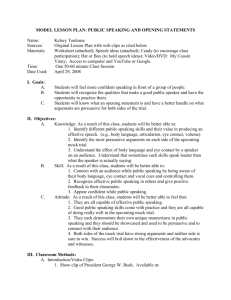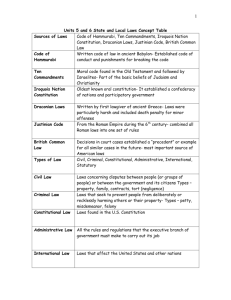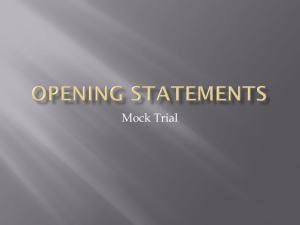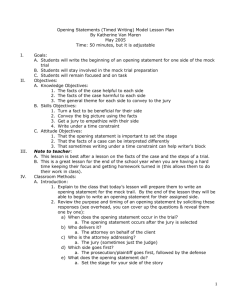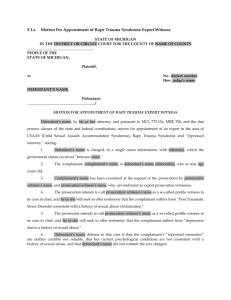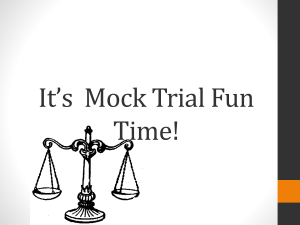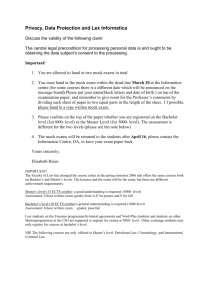Judges in the Classroom Lesson Plan
advertisement
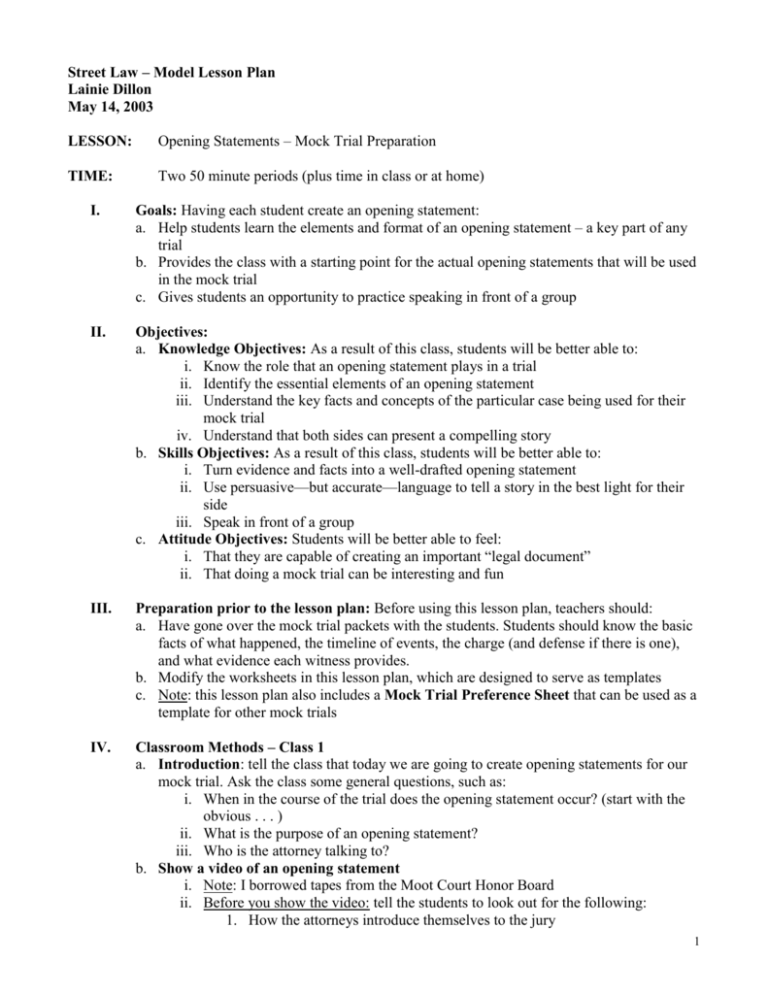
Street Law – Model Lesson Plan Lainie Dillon May 14, 2003 LESSON: Opening Statements – Mock Trial Preparation TIME: Two 50 minute periods (plus time in class or at home) I. Goals: Having each student create an opening statement: a. Help students learn the elements and format of an opening statement – a key part of any trial b. Provides the class with a starting point for the actual opening statements that will be used in the mock trial c. Gives students an opportunity to practice speaking in front of a group II. Objectives: a. Knowledge Objectives: As a result of this class, students will be better able to: i. Know the role that an opening statement plays in a trial ii. Identify the essential elements of an opening statement iii. Understand the key facts and concepts of the particular case being used for their mock trial iv. Understand that both sides can present a compelling story b. Skills Objectives: As a result of this class, students will be better able to: i. Turn evidence and facts into a well-drafted opening statement ii. Use persuasive—but accurate—language to tell a story in the best light for their side iii. Speak in front of a group c. Attitude Objectives: Students will be better able to feel: i. That they are capable of creating an important “legal document” ii. That doing a mock trial can be interesting and fun III. Preparation prior to the lesson plan: Before using this lesson plan, teachers should: a. Have gone over the mock trial packets with the students. Students should know the basic facts of what happened, the timeline of events, the charge (and defense if there is one), and what evidence each witness provides. b. Modify the worksheets in this lesson plan, which are designed to serve as templates c. Note: this lesson plan also includes a Mock Trial Preference Sheet that can be used as a template for other mock trials IV. Classroom Methods – Class 1 a. Introduction: tell the class that today we are going to create opening statements for our mock trial. Ask the class some general questions, such as: i. When in the course of the trial does the opening statement occur? (start with the obvious . . . ) ii. What is the purpose of an opening statement? iii. Who is the attorney talking to? b. Show a video of an opening statement i. Note: I borrowed tapes from the Moot Court Honor Board ii. Before you show the video: tell the students to look out for the following: 1. How the attorneys introduce themselves to the jury 1 c. d. e. f. g. 2. The language the attorneys use in talking to the jury (“the evidence will show”) 3. The theory of the case and the theme (“this is a case about . . .”) 4. How the attorneys provide “character sketches” of the key people/companies involved in the dispute 5. How the attorneys tell “their side of the story” by introducing the witnesses and describing the evidence – not by being argumentative iii. After the video: debrief on the above questions – asking students to point out the various things that were called to their attention beforehand Split the class into two sides (plaintiff/prosecution and defense) i. Note: this need not be the way the class is split for the actual mock trial Hand out Opening Statement Preparation Form – Plaintiff/Prosecution to half the class and Opening Statement Preparation Form – Defense to the other half At this point, the teachers should split up – one teacher works with the Plaintiff/Prosecution and the other with the Defense Each teacher leads their students in filling out the worksheets i. Tell the students that they will all need to turn the worksheets in at the end of class. WORKSHEETS: i. First question: What is the Prosecution’s/Defense’s goal in this case? ii. Second question: What are the elements of the charge and the defense? iii. Characters sketches: 1. Talk about the importance of how the Plaintiff/Defendant/Decedent are perceived by the jury in this case – how does each side want to portray those people/companies? 2. Students may work together or alone, but each should write a one or two sentence description of the significant characters on their own worksheet 3. Students should look to the testimony of the various witnesses to find good descriptors 4. Give students five minutes to complete their character sketches and then have three or four students read them aloud iv. Theme 1. Tell students that jurors instinctively use themes to reduce the large amount of information they hear into something they can easily remember – so attorneys should select a theme for them! 2. A theme can be a single word or a short phrase (“This is a case about taking chances.”) 3. Include key words that the jurors will hear again during witness testimony and the closing argument v. Important Facts for each witness 1. For each witness, students should identify which facts/evidence are crucial to their side a. Each side does this only for their “own” witnesses vi. Theory of the case: now students are ready to write . . . 1. A theory of the case is your side’s version of “what really happened” 2. It should incorporate all the uncontested facts and your side’s version of the contested facts 3. It should be simple to understand 2 V. Assignment after Class 1: a. After describing the idea behind a theory of the case, tell the students that now they have the chance to write their own opening statement b. Hand out the assignment worksheets, called Opening Statement – Prosecution and Opening Statement – Defense c. Tell the students that they each need to draft an opening statement i. Note: each student drafts an opening statement for the side they worked on during the lesson plan, but this need not be the actual side they’re on during the mock trial ii. Students should use the elements in the worksheet to draft their opening statements. Most opening statements should include: 1. An introduction of the attorney a. “Good morning. My name is Leah Brown and I am representing Patricia Haines, the Defendant in this case . . .” 2. A theory of the case a. “On May 31, Patricia Haines shot Jordan Davis in an act of revenge . . .” 3. Theme a. “This is a case about stereotypes and revenge . . .” 4. A character sketch of the major people/companies involved in the dispute a. “Patricia Haines was an angry woman with a grudge against the world . . .” 5. An explanation of the charge/defense a. “You will be asked to decide whether this was an act of selfdefense, which requires three things. First, . . .” 6. An introduction of the major witnesses for one’s own side a. “You will meet Kim Gerson, who has known the Defendant for many years . . .” 7. The key evidence that those witnesses will present a. “Mr. Chang will testify that Jordan Davis did not even have his knife with him that fateful night . . .” 8. A conclusion requesting a verdict a. “We ask that you find the Defendant not guilty . . .” 9. Note: teachers may want to hand out a checklist with the essential elements of an opening statement d. Students should either work on their opening statements the following day in class (arrange this ahead of time with the teacher) or should complete it as homework e. Tell the students that they all need to turn in their completed opening statements to their teacher at the end of class the following day VI. Classroom Methods – Class 2 a. Reading opening statements i. Tell the students that today everyone will get to read the opening statements they wrote ii. Alternating between Plaintiff/Prosecution and Defense, have every student stand in front of the class and read his or her opening statement 1. Bring candy or some treat to class as a reward for each student after he or she has read his or her opening statement 2. Refrain from providing feedback until all students have presented – in order to avoid adding pressure or fear of criticism 3 b. Debrief: after all students have delivered their opening statements discuss and highlight particular strengths by asking: i. Who had a particularly good theory of the case? ii. Who had a compelling character sketch? iii. Who used creative and persuasive language? iv. Who told a good story? v. Who explained and utilized the law (elements of charge and defense)? vi. Who introduced the witnesses and their key evidence? b. Note: once the class is divided into their roles for mock trial, these opening statements can be combined and edited to form the actual opening statements used in the mock trial 4 Name: ______________________________________ Opening Statement Preparation Form – Plaintiff/Prosecution 1. What is the Plaintiff’s/Prosecution’s goal in this case? “The Prosecution will prevail if the jury finds the Defendant guilty of _____________ _____________________________ AND finds that the Defendant did not act in _________________________________________.” 2. What are the Elements of the Law in this case? A. “The Prosecution must prove the elements of (the charge) ____________________ by (burden of proof) ________________________________________________________.” B. “The Prosecution must prove that the Defendant was not acting in self-defense by disproving the required elements of self-defense, which are: 1. 2. .” 3. 3. Provide a character sketch of the two main individuals in this case (one sentence for each): “Patricia Haines (the Defendant) is .” “Jordan Davis (the Decedent) was .” 5 4. What is the Prosecution’s Theme? “This is a case about .” 5. What are the most important facts/evidence that each of our witnesses bring to our case? Important facts that [Witness 1] will tell the jury: Important facts that [Witness 2] will tell the jury: Important facts that [Witness 3] will tell the jury: Important facts that [Witness 4] will tell the jury: 6. What is the Prosecution’s “Theory of the Case”? Now is your chance to write your side’s version of “what really happened”! Answer this question by completing the Opening Statement Assignment. 6 Name: ______________________________________ Opening Statement Preparation Form – Defense 1. What is the Defense’s goal in this case? “The Defense will prevail if the jury finds that the Defendant was legally justified in shooting Jordan Davis because she acted in ____________________________________.” 2. What are the Elements of the Law in this case? A. “The Prosecution must prove the elements of (the charge) ______________________ by (burden of proof) ________________________________________________________.” B. “The Prosecution must prove that the Defendant was not acting in self-defense by disproving the required elements of self-defense, which are: 1. 2. .” 3. 3. Provide a character sketch of the two main individuals in this case (one sentence for each): “Patricia Haines is .” “Jordan Davis was .” 7 4. What is the Defense’s Theme? “This is a case about .” 5. What are the most important facts/evidence that each of our witnesses bring to our case? Important facts that [Witness 1] will tell the jury: Important facts that [Witness 2] will tell the jury: Important facts that [Witness 3] will tell the jury: Important facts that [Witness 4] will tell the jury: 6. What is the Defense’s “Theory of the Case”? Now is your chance to write your side’s version of “what really happened”! Answer this question by completing the Opening Statement Assignment. 8 Name: ______________________________________ Opening Statement – Prosecution Assignment: write an opening statement for the State of Washington – the prosecution in this case. The opening statement should be based on the worksheet filled out in class and should highlight the significant evidence that supports the prosecution’s case. Make sure to include an introduction and to request a verdict at the end. The opening statement must be at least two pages long. Due: this assignment must be turned in to Mr. Stein by the end of class on Tuesday, May 6, 2003. We will read these aloud in class on Wednesday, May 7, 2003. 9 10 Name: ______________________________________ Opening Statement – Defense Assignment: write an opening statement for Patricia Haines – the Defendant in this case. The opening statement should be based on the worksheet filled out in class and should include and highlight the significant evidence that supports the defense’s case. Make sure to include an introduction and to request a verdict at the end. The opening statement must be at least two pages long. Due: this assignment must be turned in to Mr. Stein by the end of class on Tuesday, May 6, 2003. We will read these aloud in class on Wednesday, May 7, 2003. 11 12 Mock Trial Preference Sheet I. Please indicate your top three preferences for the role you would like to play in the mock trial by putting a: “1” next to your first choice “2” next to your second choice “3” next to your third choice We will do our best to assign everyone to one of their desired roles, though this may not be possible. Courtroom employees: ____ Bailiff ____ Court clerk/Time-keeper Witnesses for the State of Washington: ____ Lee Chang ____ Corey Delgado ____ Kim Gerson ____ Lynn Kowalski Witness for the Defense: ____ Patricia Haines ____ Sandy Perez ____ Jackie Thomas ____ Kelly Trumbo Attorneys (there will be multiple on each side): ____ Attorney for the State of Washington ____ Attorney for the Defense (Patricia Haines) Other possible roles: ____ Journalist (required to write a newspaper article about the trial) ____ Courtroom artist (required to draw scenes from the trial) 2. Please finish this sentence: “What I want to get out of the mock trial experience most is: __________________________________________________________________________________ __________________________________________________________________________________.” 3. If you will not be able to be at the mock trial on May 23, 2003 (12:15-2:15pm) please explain why: ____________________________________________________________________________________ ____________________________________________________________________________________ 13

